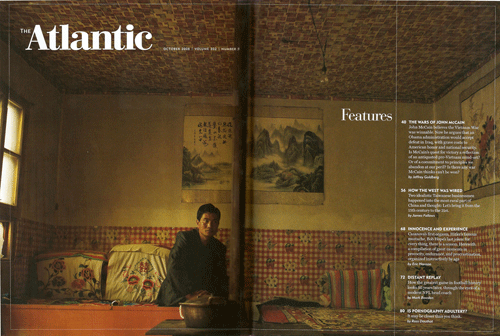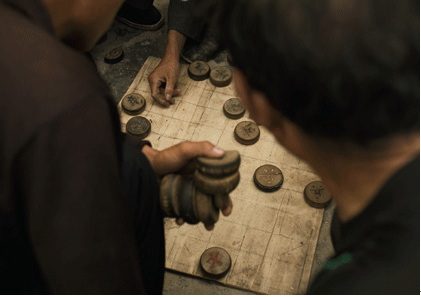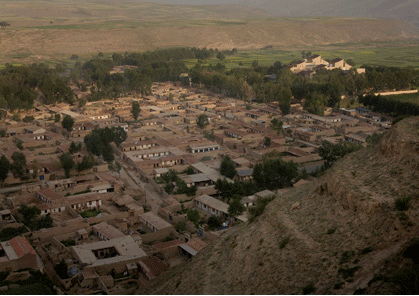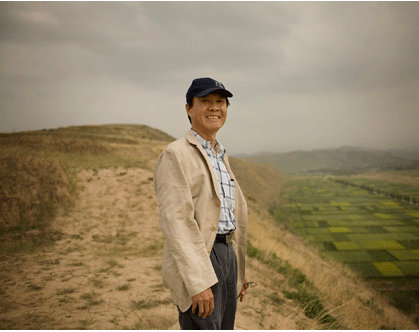Two idealistic Taiwanese businessmen happened into the most rural part of China and thought: Let’s bring it from the 15th century to the 21st.

Yan Changrong,a teacher at Xidatan Middle School in China's remote west.
You could compare the far west of China to America’s western frontier, if U.S. territory reached only to Nevada. In China as in the United States, when you head west into the continent from the crowded eastern corridor, the landscapes become drier, the trees sparser and the cities farther apart, and eventually you’re in stark desert. But in China there is no coastline with fish and forests on the other end. Just more desert, steppe, and mountain until the country reaches its borders with “the ’Stans”—Kazakhstan, Kyrgyzstan, and the rest.
In China’s history, some interior cities have been prosperous and powerful, especially when the Silk Road trade routes to the Middle East and Europe brought commerce through places like Dunhuang and Xi’an. But in modern times, to say xi bu (“the west”) in China is to signify the poorest part of the country, as “the South” meant in America for a hundred years after the Civil War.
Only a quarter of China’s population lives in the western provinces and “autonomous regions,” including Tibet. But that is more than 300 million people, roughly the entire population of the United States, many of them trapped in a kind of subsistence economy hard to imagine from the perspective of even China’s own major eastern cities. After trips to a number of these areas—Gansu, Ningxia, Qinghai, Xinjiang, the western parts of Sichuan and Shaanxi—I was sobered as I have been by nothing else in the country.
If I were running a travel agency, I would skip the likes of Beijing and Shanghai and send foreign visitors out toward these western villages, where they would see aspects of China beyond its urban spectacle and manufacturing prowess. In China’s most famous cities, tourists are surprised by the scale, speed, intensity, and ambition of the activity all around them. But seeing all this firsthand mainly gives a more detailed confirmation of the impression they already had. Even the poverty of the big cities, impossible to ignore and startling because it appears right next to the fanciest luxury projects, involves people who are connected to the modern world: for instance, migrant construction workers live very dangerous and oppressed lives, but they work on fancy high-rise office buildings and new freeway overpasses.

WESTERN CHINA'S Yellow Sheep River Valley
But in the villages, people effectively live in a different century. Their families may exist on the cash equivalent of $10 or $15 per month. Their entire life experience may be encompassed within a radius of 10 or 20 miles. When my wife and I visited a high school in an ethnic Tibetan village in Gansu province, we were the first foreigners the students—or any of their teachers, or the principal—had ever seen outside of textbooks. At that school and others in the west, we talked with children who went to school in some years and didn’t in others, depending on whether their families had sold enough crops to pay the public-school fees. This is not the China that most foreigners read about or experience on visits, but its isolation and poverty are important parts of any understanding of China.
To my taste, the arid western provinces are the most beautiful areas of China. The eastern seaboard is mainly flat, featureless, overdeveloped, and devastated. Much of the west is awe-inspiring to see. This is the austere beauty of the desert: limitless vistas, clear skies, dramatic topography, an unforgiving environment for life of any kind.
Several of the trips we took through western villages were in the company of a Taiwanese-born software expert in his early 60s named Kenny Lin, who is now engaged in the most touching and quixotic enterprise I have seen in China—one that my wife and I felt moved to support after seeing its effects in rural schools. During the year I’ve followed Lin, I’ve found his efforts both fascinating and significant, in this sense: They underscore the depth of the economic challenges today’s mighty China still faces. And they suggest the power of a new way of dealing with those challenges. This involves neither the government edicts that have guided the economy for decades nor the me-first capitalist vigor of recent years, but instead a deliberate use of market incentives and technological tools in what Kenny Lin calls an altruistic way.

ON THE STREETS in Yellow Sheep River, farmers often play Chinese chess, or xiangqi, in the time between planting and harvest
To see what this means in 2008 requires going back more than 40 years, to Lin’s friendship in Taiwan with his college classmate Sayling Wen.
In the summer of 1966, Lin and Wen started college in the electrical-engineering department of National Taiwan University, in Taipei. Lin’s father was a doctor and politician; Wen’s, an electrician who died when his son was young. Wen was smart and the most diligent among his group of friends. After graduation in 1970 and mandatory military service, he joined one of the small electronics companies then proliferating in Taiwan. Over the next quarter century, he grew very rich, as Taiwan went through an outsourcing and manufacturing boom like the one that more recently got under way in mainland China.
As the mainland Chinese economy opened in the 1990s, business opportunities, plus his own curiosity, led Wen to spend more and more time on the mainland. In 1992 his company, Inventec, built its first mainland factory, in Shanghai. Wen had long been a man of passions and pet projects. For instance, from the start of his career, he was convinced that the right English-teaching software could make it easy for Chinese speakers to learn English and, in his view, end their isolation from world discourse. (So far, no dice.) In 2000, he developed a new and very powerful passion: to save the poor people of western China.
During the 1990s, Wen had traveled incessantly through China’s industrial areas. In the summer of 2000, he had his first exposure to the driest and perhaps most challenging of the western regions: Gansu province, in the windblown yellow-earth plateau on the edge of the Gobi Desert. At an economic conference in Gansu’s capital, Lanzhou, he heard officials compare China’s development of its western frontier to the development of the American West, a process that would unfold over many generations.
Wen strongly disagreed. He stood up to say that even a 50-year target was unacceptable. For one thing, it was too far off to fit into any business’s investment plans. With the advantages of airplanes, telecommunications, and global trade, progress should be much faster. Moreover, the 300 million people living in the arid west were “like us, all children of the Yellow Emperor, sharing the same ancestral blood,” yet still living in poverty. If China let them languish another 50 years, “their suffering would be unbearable.”
He had a new idea: western China would have to become fully modernized—brought into parity with Shanghai and Beijing—by 2010. Soon he had written a manifesto called Develop Western China in Ten Years, which was published in English and Chinese, and he steered Inventec’s money toward sites in the west. He also learned that he would have an unexpected ally: his old classmate Kenny Lin.
In the years after college in Taipei, Kenny Lin went to the United States, earned a doctorate, and had a successful 20-year run as an engineer, researcher, and manager, winding up at Bell Labs and NYNEX. He married a woman from Taiwan, became a U.S. citizen, and raised two children. But China’s opening under Deng Xiaoping attracted him, and after investigating various possibilities, he left the United States and in 1993 started a software center in Tianjin, outside Beijing, for his friend Sayling Wen’s Inventec company.
One of Lin’s engineers in the Tianjin software facility, Peng Haina, had spent a year as a volunteer teacher in a remote, desolate village in Gansu province called Huang Yang Chuan, literally “Yellow Sheep River.” It lay at the junction of two shallow streams in a gorge 8,000 feet above sea level. The village of several thousand people had two streets. Most families lived in mud-brick-walled courtyard buildings where their sheep and cattle also slept. Inside their homes, they kept warm in the frigid high-altitude winter by burning charcoal or animal dung in the lower part of large rectangular brick structures called kangs. They sat and slept on top.

SUDDEN CHANGE: the Yellow Sheep River Valley convention center, right, next to adobe village homes
Economically they survived by grazing sheep on already overgrazed, dry, and rapidly eroding hillsides, and by growing wheat and potatoes when there was enough rain. The people of Yellow Sheep River came into virtually no contact with the world beyond their little gorge, except when young men and women who had fled hundreds of miles to take factory jobs returned for a few days each year during the Chinese New Year holiday to see their hometown, and often the children they had left behind.
Peng encouraged his Inventec colleagues to donate books and computer equipment to the school and told Lin that he, too, should visit western China, which he had never seen. In late September 2000, Lin went to Yellow Sheep River. What he saw changed the direction of his life.
In a book recounting that visit, which he wrote during a two-week burst, Lin described the hardships of the life he had seen in the hinterland—and also a solution that had come to him. It was a solution in the same spirit that had already motivated his old classmate Wen, though at the time he had no idea of Wen’s own interests.
The hardship that stunned him most was the powerlessness of rural people against brute natural misfortune. A bright and promising young girl had made it through elementary school—but then a drought dried up the crops, and her peasant parents pulled her out of school because they didn’t have money for the fees. In an hour-long video documentary Lin made to accompany the book (available at YellowSheepRiver.com), he showed the peasant parents saying they mainly wanted to get the girl married off as soon as possible. (An uncle then gave her money for school.) Another boy was shown sobbing about the dim fate that awaited his younger sister, who had been pulled out of elementary school to save money and would remain uneducated like their parents. “Oh God, help these simple and innocent children out of the poverty, deliver them from the tortures of the lack of rain,” Lin wrote.
His immediate impulse was direct charity. On his first visit, Lin pledged 2,500 RMB per month, about $365, to pay for meat in the school lunches and for fuel to boil drinking water. But he believed in “teach a man to fish”–type help rather than long-term charity, and so he conceived his scheme.

KENNY LIN, born in Taiwan and long a U.S. resident, found his calling in the rugged, rural west of China.
The villagers’ fundamental problem was their isolation. The Internet could solve that! Lin’s branch of Inventec could give more computers and software to the school. It could work with the local government to bring in a broadband line and set up a computer center that everyone in the village could use. The students could take courses far beyond the range offered by their impoverished school. They could communicate with people they had not known all their lives. The local farmers could use the Internet to learn about the weather and market conditions. Local craftsmen could offer items for sale to distant customers. Working-age people could look for good factory jobs elsewhere. “The shackles that had bound their spirits had been taken off,” Lin wrote after he had, within a few weeks of his first visit (things happen fast in China), established the computer center, declared Yellow Sheep River an “Internet village,” and created the Yellow Sheep River Web site.
It was just after his momentous first trip into the mountains that Lin saw Sayling Wen again. The year 2000 was the 30th anniversary of their college graduation, and Wen sent a note to his classmates saying that he was now so rich, he’d throw a celebration in Shanghai for the entire class and their families at Christmastime and pay their way. (His choice of Shanghai for a reunion of Taiwanese alums is an indication of the near-total integration of the mainland and Taiwanese economies.) On Christmas Day, he overheard Kenny Lin say that Yellow Sheep River now gave purpose to his life. Neither man had known about the other’s recent interest in western China. Both had converted to Christianity, and both thought of helping western China partly as a spiritual obligation.

TEACHING TECH: Liu Li helps 10-year-old Shi Xiaomeng at an "animation camp" held in Yellow Sheep River's convention center
Wen told Lin about his vision of parity with the big cities within 10 years for these destitute areas and said that the “Internet village” was the model he had been looking for, since it could leapfrog the long process of industrialization and bring villagers directly into the telecommunications age.
Very soon, Wen had founded and funded a new company and put Lin in charge. Its name in English is “Town and Talent Technologies.” Everything about it reflected Wen’s love for the grand gesture. Had Lin brought the Internet to one village? It should come to a thousand villages. Might it cost $50,000 to equip, operate, and maintain each village’s new computer center? Then Wen should commit $50 million, to cover all thousand villages.
Plus an extra $4 million, for what Wen saw as the crowning touch: a five-star luxury conference center in Yellow Sheep River itself, kind of an Aspen or Jackson Hole without the rich people. There Chinese visitors from the rich eastern cities could see how their countrymen lived, and so could visitors from around the world. Wen kept adding new specs and features to the resort. A conference room with special acoustic tile and high-end video projectors. A swimming pool with the latest “antiwave” design to prevent needless ripples, plus a gym. Naturally, broadband in all the rooms.
Wen used his connections and pull to interest governmental and industrial groups in the project, and he kept encouraging and funding Lin’s work. Then he dropped dead.
In December 2003, as Town and Talent was setting up Internet projects at more than 50 western schools and as the external structure of the resort was being finished, Sayling Wen suddenly suffered a stroke. He’d always been overweight—standing behind him in line for mandatory fitness training back in their first week of college, Kenny Lin had been startled to see Wen weigh in at 99 kilos, 218 pounds, and strain valiantly but be unable to complete a single pull-up. (Lin, in contrast, was and is a physical-fitness fanatic.) But Wen had seemed vigorous and healthy. He was taken to the hospital and within three days had died, at age 55.
Kenny Lin was devastated for his friend, and he was also in trouble. Wen had given him only $1.2 million of the promised $4 million total for the resort. “I had 400 construction workers ready to start on the interior,” he told me. “No one knew where the other $2.8 million was.” Wen had apparently told no one else in the company about his commitment. Lin stalled the workers, telling them that the hotel might become a school. He feared a riot if they knew that the whole project was at risk. Finally, in March 2004, after three months of Lin’s pressure and pleading, one of Sayling Wen’s brothers agreed to provide the missing $2.8 million.
By the end of 2004 the conference center was done, and officials from around China attended a grand-opening ceremony. “But our original business model was lots of conferences, and Mr. Wen, with his connections, was the central part of that model,” Kenny Lin told me. “Now there is no one to invite the people he could bring.”
Lin told me this in the summer of 2007, as my wife and I walked along the echoing marble floors of the conference center, beneath a larger-than-life-sized portrait of Sayling Wen. We had heard about Yellow Sheep River, which has been well publicized in China, and had gotten in touch with Lin through mutual friends. In the 145-room resort, we appeared to be the only paying guests (the list price is about $100 a night). A full, uniformed staff was on hand—to welcome us to the breakfast buffet, to hand us towels at the pool and exercise room, to greet us when we went in and out the front door.
I have seen deserted resort-palaces before—for example, a ghostly one in the Ilocos area of northern Luzon, which Ferdinand Marcos had built strictly for his daughter’s wedding and which stayed open, empty, for years after he was deposed. But this was different, in retaining an air of hopefulness rather than sheer decadence. And hopeful is how I feel about the several legacies of Sayling Wen’s vision for western China.
The resort itself is of course the most visible of these legacies. When I run my travel agency, I will send every foreign group there I can. By international standards, it is no longer super-luxurious. But for foreigners it is comfortable, which cannot be said of many other places where outsiders are a two-minute walk away from village life. Unlike similar “comfortable” lodgings in places like Haiti or West Africa, it creates little sense of surviving behind barricades in a gilded cage. The hotel and conference center are in the middle of ordinary peasant fields but not besieged by desperate local crowds. As in much of China, including some areas of the west, my wife andI walked through the region chatting with farmers and children in basic Mandarin without causing too much of a stir.
Kenny Lin, who turned over management of the resort to a colleague in 2005, was aiming for a high-end international crowd of visitors. He knew that the surrounding mountainous area would appeal to Western hikers, mountain bikers, and horse-riders. The highland scenery is breathtaking, like Wyoming or the Canadian Rockies, with numerous white yaks in place of bison or bears. (Breathtaking literally, too. While my wife rode horses among the yaks with Lin, I foolishly attempted to run along a path in the same highland meadow, only to stop in my tracks 10 seconds later. It turns out that the meadow is at an elevation of 11,000 feet.) The resort’s new manager has decided that the domestic Chinese tourist and conference business, a very rapidly growing market, offers the best prospects, and reportedly has booked enough of them to keep the business running.
A second legacy of Sayling Wen is the Town and Talent company, with its plan to bring the power of the Internet to isolated villages. The strategy behind that plan has also changed significantly since Lin’s first trip to Yellow Sheep River, eight years ago. Then, he thought the Internet could best help the young people of Gansu by helping them move away. They could learn what they needed to know to take factory jobs, and then be matched with big employers in the big cities. “Outsourcing labor to factories was a big economic success,” Lin says, “but ethically, we couldn’t be responsible for what happened to the kids. They were country children. They didn’t know how to handle money in the big cities. They didn’t know how to make friends or even cross streets.”
Now Town and Talent’s strategy is the reverse. It still wants to help children leave subsistence farms, on land that was barely farmable even before the drought and has been overused to the point of exhaustion. But instead of speeding their departure to the east and further straining family and social ties, it is trying to use the Internet to create new jobs in western China’s cities. To oversimplify, the plan has similarities to India’s success in creating call-center and tech-support jobs in Bangalore and Hyderabad, except here the idea is to attract jobs that might otherwise end up in Shanghai, Hangzhou, or some other booming eastern Chinese city. Town and Talent has set up programs in more than 150 schools in western China to train students in using computers (which it donates) and the Internet, so they will have a better chance of holding tech jobs or starting companies of their own.
The final legacy is outright philanthropy, the current version of Sayling Wen’s obviously impossible dream of modernizing the west within 10 years. The Town and Talent company devotes 10 percent of its efforts to a project whose English name is “West China Story” and whose goal is to connect students in remote villages with the outside world.
In this program, middle-school and high-school students in distant areas apply for a kind of work-study grant. The standard amount, about $115, covers most of their yearly school expenses and so can keep them enrolled even when times are bad. (In many of the schools I’ve seen, the students sleep in cramped concrete dorm rooms on weeknights, because their homes are too far away for daily travel by bus or on foot. Part of the fee is to cover their food at school.) In exchange they must, essentially, become bloggers. At least 10 times per year, they are required to research, write, illustrate, and post on the Web a report on some aspect of their lives in the countryside. The idea is to remind them that they are earning their way and not being given a favor, while at the same time teaching them modern Web-site-design skills. In addition, teams of students put up elaborate multipage Web sites—on the prospects for wind turbines in perpetually gusty western areas, on the history of irrigation systems in the Yellow River basin of Ningxia—some of which have won prizes in international high-school “cyber-fairs.”
The essays are available at WestChinaStory.com; they are in Chinese, but the students correspond with site visitors in simple English as part of their training. Many of the pictures are eloquent, regardless of language. (Town and Talent gives each school one digital camera, which the students share.) One middle-school student writes about the “moment of joy” when the family wheat crop is ready for harvest. A high-school boy tells about how great it was when his school got a basketball to play with outside. Another, about learning Tibetan dance. Another, what is hard but satisfying about herding sheep. It might sound maudlin, but having met some of these children, I take their accounts as alive, hopeful, human.
Some 2,200 rural students now earn their keep through this kind of blogging, supported by half a million dollars in donations mainly from Taiwan, Hong Kong, the United States, and a few businesses in mainland China. My wife and I signed up to “hire” a number of blogging students from the school that welcomed us. (On the site, you can not only see all of the students’ essays in Chinese and their pictures but also choose students to sponsor at 800 RMB, or about $115, per year.) I’d like to know what becomes of them.
“The children in these villages have so many disadvantages,” Ted Wen, Sayling’s son, told me when I met him in Taipei. “They do not have a fair chance.” For instance: Chinese universities reverse the logic of U.S. affirmative-action programs. Rich and poor students alike take the gaokao, the nationwide admissions test. But to get into the famous, career-making universities, a poor student from the hinterland must score higher than a rich kid from an elite urban school. (This is the practical effect of a system whose stated bias is in favor of students from each university’s own geographical area, and where the best universities are in the biggest, richest cities.)
Ted Wen is a suave figure in his early 30s who studied computer science in Japan and California before returning to Taiwan after his father’s death to “get involved in my father’s unfinished business,” as he wrote to me in an e-mail. He said that his father’s vision for western China was in part purely practical: if Taiwanese businesses did good things for mainland China, maybe people on the mainland would look favorably on Taiwan. But it also had a moral core. “I think it was important to my father to give children in the west a fairer chance to compete.”
That effort might be doomed. The children might still have no hope. The west of China may still be poor 10 years from now, and a hundred. But in a big, bustling country where many people are thinking mainly about what’s profitable, it’s worth noticing the ones who are thinking about what’s fair.
|